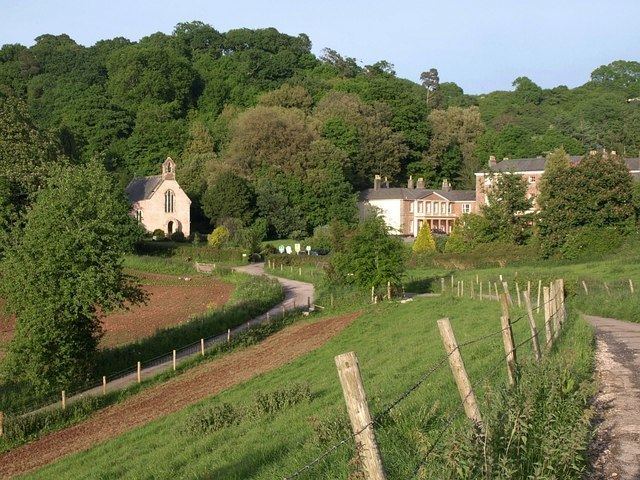Haccombe is a hamlet and historic manor in Devon, situated 2 1/2 miles east of Newton Abbot, in the south of the county. It was perhaps the smallest parish in England, and was said in 1810 to be remarkable for containing only two inhabited houses, namely the manor house known as Haccombe House and the parsonage. Haccombe House, is a "nondescript Georgian structure", built ca. 1800 but a mediaeval mansion house existed previously on the site. Next to the manor house is the small parish church dedicated to Saint Blaise, remarkable for the many ancient stone sculpted effigies and monumental brasses it contains, amongst the best in Devon. The benefice is occupied by an incumbent with the rare title of Archpriest. The archpresbytery was established in 1341 with six clergy; only the archpriest survived at the Reformation. The parish is combined with that of Stoke-in-Teignhead with Combe-in-Teignhead. Haccombe with Combe is a civil parish in the Teignbridge local government district
The manor was the seat of important branches of the Courtenay and Carew families.
The descent of the manor of Haccombe was as follows:
The earliest recorded holder of the manor was the de Haccombe family, which as was usual took its surname from the manor.
Stephen I de Haccombe, who is recorded as holding the manor in 1242.Sir Jordan I de Haccombe, successorSir Stephen II de Haccombe, successorJordan II de Haccombe, successor, who married the daughter and heiress of Mauger de St Awbin, but left no male progeny, only a daughter and sole-heiress Cecily de Haccombe, wife of Sir John Archdekne, to whom passed the manor.Sir John Archdekne, who married Cecily de Haccombe, heiress of Haccombe, by whom he had in the words of Risdon (d.1640) "A fruitful progeny especially of issue male". However, of his nine sons only two left progeny, namely Sir Warren Archdekne, second son and eventual heir; and the third son Richard Archdekne who had a son Richard Archdekne who died without progeny.Sir Warren Archdekne, second son and heir, who married Elizabeth Talbot, a co-heiress of John Talbot. He left no male progeny, only three daughters and co-heiresses, including Phillipa Archdekne, eventual heiress of Haccombe, the second wife of Sir Hugh Courtenay (c.1358-1425).Sir Hugh Courtenay (c.1358-1425), of Haccombe and of Boconnoc in Cornwall, who married as his second wife Phillipa Archdekne, heiress of Haccombe. He was a Member of Parliament and Sheriff of Devon, a grandson of Hugh de Courtenay, 2nd/10th Earl of Devon (1303–1377), was the younger brother of Edward de Courtenay, 3rd/11th Earl of Devon (1357–1419), "The Blind Earl", and by his third wife was the grandfather of Edward Courtenay, 1st Earl of Devon (d.1509), KG, created Earl of Devon in 1485 by King Henry VII. His marriage to Phillipa Archdekne was without male progeny, but did produce a daughter Joane Courtenay (born 1411), the wife of Nicholas III Carew of Mohuns Ottery in Devon, and the eventual sole-heiress of her mother Phillipa Archdekne, from whom she inherited 16 manors including Haccombe, which she divided amongst her younger Carew sons.Nicholas III Carew of Mohuns Ottery in Devon, who married Joane Courtenay (born 1411), a daughter of Sir Hugh Courtenay (1358–1425) of Haccombe and of Boconnoc. As her eldest son was already well provided for as the heir to his father's estates of Mohuns Ottery and others under primogeniture, Joane Courtenay gave Haccombe to her second son Nicholas Carew, as was common practice in such situations, who founded there a prominent junior branch of the Carew family. (See Carew baronets (1661) of Haccombe). Risdon however states the reason for Joan Courtenay having passed over her eldest son in distributing the Haccombe estates was "for some defect of a due respect to his mother (as she conceived)". The Carew family of Haccombe obtained a baronetcy in 1661, still extant today, and continued to reside at that estate until the 19th century, having earlier inherited further estates from other advantageous marriages, including Bickleigh, inherited by Sir Thomas Carew, 1st Baronet (d.1673/4) following his first marriage to Elizabeth Carew, eldest daughter and co-heiress of Sir Henry Carew of Bickleigh and Tiverton Castle, the ancient seat of the Courtenay Earls of Devon, which latter was inherited by Sir Thomas Carew, 4th Baronet of Haccombe from his marriage to Dorothy West, a daughter and co-heiress of Peter West of Tiverton Castle. Joan Courtenay survived her husband and married secondly, by royal licence dated 5 October 1450, Sir Robert Vere, second son of Richard de Vere, 11th Earl of Oxford, by whom she had a son, John Vere, father of John de Vere, 15th Earl of Oxford.
